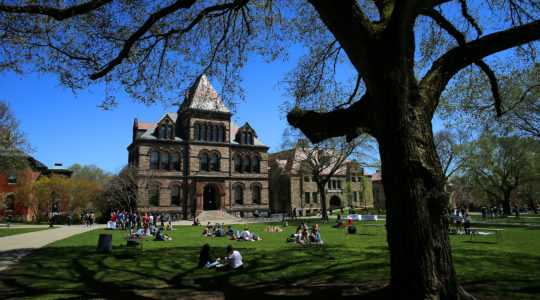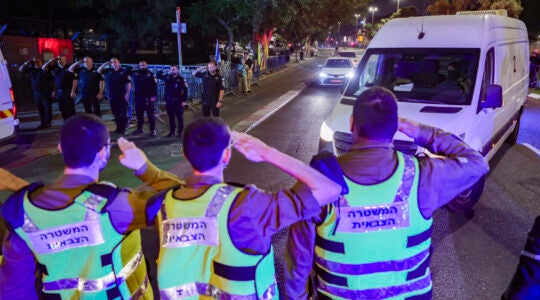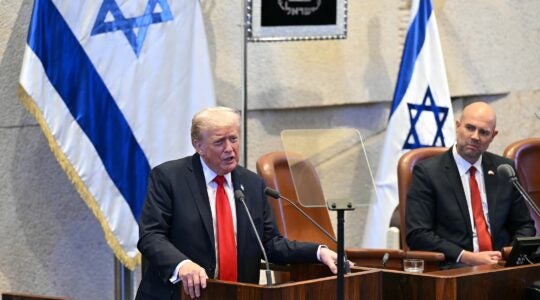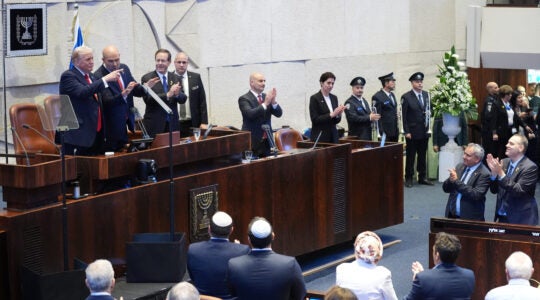
New York Mayor Michael Bloomberg, third from left, and Police Commissioner Ray Kelly, second from right, visit the Riverdale Jewish Center, one of two Bronx synagogues targeted in a foiled bombing plot, on May 21, 2009. ((Ed Reed/Office of the Mayor))
WASHINGTON (JTA) — The arrest of four men accused of plotting to attack two Bronx synagogues underscores the threat to Jewish targets by individuals or small groups, several experts said.
From the shooting at a Los Angeles Jewish community center 10 years ago through the attack on the Seattle Jewish federation building in 2006, to the individual targeting Jews at Wesleyan University in Connecticut earlier this month, an individual or small group not formally connected with al-Qaida or any major international terrorist group was at the center of the threat (see list of attacks).
Steve Pomerantz, former assistant director and director of counterterrorism at the FBI, compared the lessons from Tuesday’s arrests to the popular book “All I Really Needed to Know I Learned in Kindergarten.”
“All you need to know about terrorism you can learn from this case,” he said, asserting that Jews will always be at the top of the list of targets for terrorists and that groups unaffilaited with a large international terrorist group are “at least as dangerous” as well-known groups such as al-Qaida because they can “more easily slip through the intelligence net.”
Paul Goldenberg, the executive director of the Jewish-organized Secure Community Network, stressed “one common denominator” present in all those past plots: hostile surveillance by the attackers.
“They were methodical enough and premeditated enough to plan and study the target,” said Goldenberg, whose organization was established 3 1/2 years ago by the United Jewish Communities and the Conference of Presidents of Major American Jewish Organizations to coordinate and advise on security procedures within the Jewish community.
For example, the criminal complaint for the New York plot states that last month, one of the defendants “photographed several synagogues and Jewish community centers in the Bronx and elsewhere for consideration as possible targets in a planned terrorist bombing campaign” and said bombing one of the JCCs would be a “piece of cake.”
That’s why employees and others at Jewish institutions need to be “extremely cognizant” of what’s going on around the facility, Goldenberg said, because individuals could be watching the building, studying the patterns in which people enter and the times security guards patrol the surroundings.
“If people are acting nervous in a location where they shouldn’t be, say something,” Goldenberg said, adding that while most institutions have video camera surveillance, personnel must be trained to spot potential dangers.
The fact that the suspects in the New York case and others acted independently and are not affiliated with any foreign terrorist group, Goldenberg said, does make it “very difficult to track them.”
But “just because they’re not members doesn’t make them any less dangerous,” he said, adding that they’re “influenced by the materials they read.”
Goldenberg stressed that with Tuesday’s arrests, there is “no further threat to any Jewish institution” from the plot.
Pomerantz also noted reports that the plotters met in prison, similar to the four men arrested in Los Angeles in 2005 on charges of plotting terror attacks on Jewish and military targets.
Yehudit Barsky, who has been tracking that issue as director of the American Jewish Committee’s division on Middle East and international terrorism, said prisoners often are attracted to Islam when incarcerated because of the “cohesiveness of the group.”
“There are different social networks in prison” and Muslims will often pray together, eat together and protect each other, she said.
Learning about Islamist ideology comes later, often as prisoners start reading materials in prison libraries — publications that have, like many other religious publications, been sent free to the facility, she said.
While the First Amendment makes monitoring such materials a sensitive matter, Barsky believes that the United States needs to confront the issue.
The defendants are likely to argue in their defense that they really were not that involved in the plot and that the government informant, who allegedly acquired the weapons for them, actually had directed the operation.
Pomerantz said the fact that the plot went as far as actually planting the weapons — although inoperative — made it unlikely that such a defense could be successful.
“This is as good a case as you can have,” he said.
JTA has documented Jewish history in real-time for over a century. Keep our journalism strong by joining us in supporting independent, award-winning reporting.





